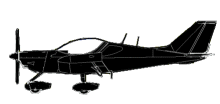
ASN Wikibase Occurrence # 187529
This information is added by users of ASN. Neither ASN nor the Flight Safety Foundation are responsible for the completeness or correctness of this information.
If you feel this information is incomplete or incorrect, you can submit corrected information.
| Date: | Sunday 22 May 2016 |
| Time: | 13:32 |
| Type: |  CZAW SportCruiser |
| Owner/operator: | Santa Monica Flyers Inc |
| Registration: | N1111X |
| MSN: | 08SC176 |
| Year of manufacture: | 2008 |
| Total airframe hrs: | 3423 hours |
| Engine model: | Rotax 912ULS |
| Fatalities: | Fatalities: 0 / Occupants: 1 |
| Aircraft damage: | Substantial |
| Category: | Accident |
| Location: | Santa Monica Municipal Airport (KSMO), Santa Monica, CA -
 United States of America United States of America
|
| Phase: | Landing |
| Nature: | Training |
| Departure airport: | Santa Monica, CA (SMO) |
| Santa Monica, CA (SMO) | |
| Investigating agency: | NTSB |
| Confidence Rating: |
The student pilot had just completed two uneventful takeoffs and landings in the light-sport airplane. As he approached the runway's hold-short line to wait for the third takeoff clearance, a pilot from another aircraft in the traffic pattern declared an emergency. The student remained in the airplane with the engine running for about 20 minutes before receiving a takeoff clearance. Data from the airplane's engine monitor indicated that, while the airplane was waiting, multiple engine temperature limits were exceeded, and the fuel flow became erratic. The student did not notice the exceedances, and shortly after takeoff, the engine lost partial power, and the airplane began to descend. The student then initiated a 180° turn back toward the airport. The airplane landed long, and the student was unable to slow the airplane before it departed the elevated section of the runway and fell 10 ft. The airplane sustained substantial damage to the firewall and lower fuselage structure.
The engine monitor data revealed that, during the first two previous takeoffs and landings, the fuel flow indications were normal. However, as stated previously, after the airplane had been holding short for about 20 minutes awaiting clearance for the next takeoff, multiple engine temperature limits were exceeded, and the fuel flow indications began to oscillate. Once the takeoff began, the fuel flow continued to oscillate, indicating that the fuel flow to the engine was experiencing intermittent interruptions, which was consistent with the fuel system experiencing vapor in the fuel lines (vapor lock). The vapor lock was likely caused by the engine bay becoming hot during the extended ground hold after the airplane had previously being flown for two flights, which resulted in heat-soaking of the fuel system.
About 4 years before the accident, the engine manufacturer amended its engine installation manual to recommend the installation of a fuel return line, which was designed to prevent engine malfunctions caused by the formation of vapor in the fuel system. Examination of the airplane's fuel system revealed that a fuel return line had not been installed.
The airplane manufacturer did not mandate the installation of a fuel return line until about 17 months after the accident, at which time, it issued a safety alert mandating the installation of the fuel line in accordance with the updated engine installation manual. Ten months later, the airplane manufacturer issued another alert, recommending updates to the Pilot's Operating Handbook by adding a warning that contained procedures to follow to limit the possibility of vapor lock. However, although the lack of a fuel return line could have contributed to the development of vapor lock, it more likely occurred because the student allowed the engine to overheat during the ground hold.
Probable Cause: A partial loss of engine power during takeoff due to vapor lock. Contributing to the accident was the student pilot's failure to notice that the engine had exceeded multiple temperature limits and that the fuel flow had become erratic during an extended ground hold, which led to the vapor lock.
Accident investigation:
 |
|
Sources:
NTSB
Location
Revision history:
| Date/time | Contributor | Updates |
|---|---|---|
| 23-May-2016 04:43 | Geno | Added |
| 23-May-2016 19:32 | Geno | Updated [Aircraft type, Registration, Cn, Operator, Total occupants, Source, Narrative] |
| 21-Dec-2016 19:30 | ASN Update Bot | Updated [Time, Damage, Category, Investigating agency] |
| 06-Jul-2019 19:35 | ASN Update Bot | Updated [Nature, Departure airport, Destination airport, Source, Narrative, Accident report, ] |
Corrections or additions? ... Edit this accident description
The Aviation Safety Network is an exclusive service provided by:


 ©2024 Flight Safety Foundation
©2024 Flight Safety Foundation